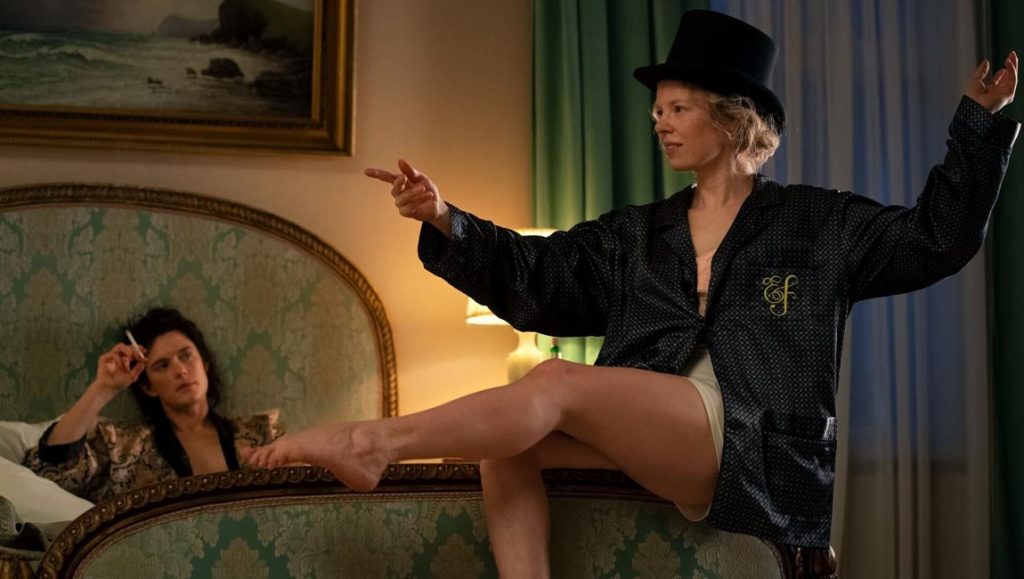Tove disrupts standard biopic conventions and mines meaning from its language-heavy approach.
In a 1946 letter to her love Vivica Bandler, Swedish writer and artist Tove Jansson wrote: “I know you don’t believe there is an afterwards. How surprised you will be, Vi, when I come floating along on a little cloud one day and say, ‘Hello! Do you still want me?’” Finnish filmmaker Zaida Bergroth, here clocking her fifth feature but yet to break out in an international context, builds Tove from that afterwards. In reflection, the film creates an artificial artistic origin story, choosing a seemingly arbitrary career point to posit artistic breakthrough. Framed by Jansson and Bandler’s love story, Bergroth chooses to focus her film on the relationships that lend themselves to art; here, it’s less that the personal is political, but instead cultivative.
Tove’s writing is essential, in that wordplay is just as keen in her later writing as it is in the era of the script. Eeva Putro and Jarno Elonen’s screenplay seeks to deconstruct language. Tove (played a strangely entrancing Alma Pöysti) speaks backwards in places; she and Vivica (Krista Kosonen, who some may recognize from Dogs Don’t Wear Pants) will swap the letters within their words, creating a common language between them. This shared, literal love language —or perhaps love code — is playful, indebted to a childlike nostalgia of inventing new words in the same way one would draw from imagination. This wordplay arises not in moments of stress and delusion, but rather in moments of romance, the two women firmly young in love.
Tove and Vivica often use a diminutive feminine construct of Swedish when referring to one another, the nicknames Tofslan and Vifslan that would later become the names of characters in Tove’s Moomin comics (it’s worth noting that English translations renamed them Thingumy and Bob, creating a masculinized character to mask their origin, and that much of this nuance is lost in subtitling). Wordplay like this would also be used for the character Too-Ticky (named after Tove’s life partner Tuulikki Pietilä), rooting art in reality, dedicating pictures and a legacy to loved ones that accumulate over time. Instead of reading the letters the two exchanged aloud, the manner in which we know the origin of them, the couple tease each other with the nicknames in bed, lost moments given color only now.
The way the intimacy between Tove and Vivica is shown highlights their joy, while the strain of their relationship from heteropatriarchal influences is where the fairytale magic of their story wipes away. Love is shown as the joy of laughter in intimate moments. It is the two women dancing, bright smiles alone in their room and quieter gazes in the shadows of a party raging indoors; it’s also found in costumed theatrics and a look of wonder. Love becomes the height of Tove’s art, and its downfall, inspiring playful children’s stories, art that has their shared heart poured into it. It’s common that biopics of great artists will focus on women’s lovers, with Big Eyes as a major culprit, and Tove fixes the same focus, but Bergroth is here aware of the profound, authentic intersection between life and imagination. Specifically in this film, the origins and references of the cartoons are traced thanks to a committed awareness of the artist’s intrinsic part of her art.
Admittedly, Tove errs on the side of crowd-pleasing, but its richly romantic, playful vision isn’t lost among such aims. The amber-hued, saturated color palette — reminiscent of Kantemir Balagov’s Beanpole — casts a twilit lens, quiet moments in evenings threaded together for a behind-the-pen view of the letters. Bergroth’s film is told from that afterwards that Tove speaks of — aware from the beginning that this will be an inciting love, not one that lasts. The two women come to different conclusions in their love story as both try to hide it, with Tove having gone to what she would call the “spook side” of her writing, while Vivica would shy away from this part of her life. In our afterwards, we watch as Tove emancipates herself through building her own artistic brand, and community, and no longer needing to make things work with her lover, who is, finally, in a different place than she is.


Comments are closed.